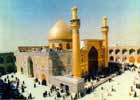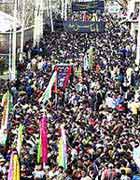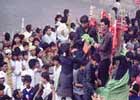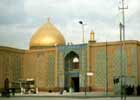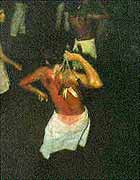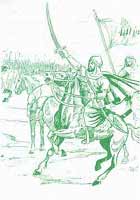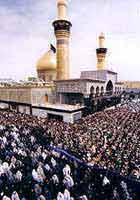Contrary to popular belief, Muharram is not a particular day, but the name of the month itself. It is one of those four months that have been designated as holy -- the other three being: Dhul-Qa’adah, Dhul-Hijjah and Rajab.
Apart from the tragic events of Karbala, the month of Muharram is associated with many notable auspicious events in Islamic history. Almighty Allah [5] created Universe: the heavens and the earth in this blessed month.
Allah created Hazrat Adam in this month, accepted his repentance and pardoned him of his mistake. Hazrat Noah’s Ark landed successfully on Mount Judi during this time centuries ago. He is also believed by the Muslims to have saved Hazrat Ibrahim [6] from Nimrod’s fire and rescued Hazrat Musa [7] from the wrath of Pharaoh and his chasing army during the month of Muharram.
The tenth day of Muharram or Ashura is of supreme importance for Shiite Muslims as they mourn the martyrdom of Imam Husain, the grandson of Prophet Muhammad.
After the death of the Prophet, differences appeared on the question of his succession. The community was divided into two sections: Sunnites who believed in human election and Shiites who believed in Divine selection. First group elected Hazrat Abu-Bakr, followed by Hazrat Umar, Hazrat Usman and then Hazrat Ali [8]. This arrangement was totally unacceptable to the rival group who called themselves as Shiites [9]. Their viewpoint was that Hazrat Ali was the closest, most loyal and faithful and most competent companion of the holy Prophet besides being his first cousin and also his son-in-law.
After the Senior Caliphs, Islam witnessed a total change in its political set-up and a new concept emerged – kingdom in the guise of caliphate. Holy Prophet’s immediate descendents, Imam Hasan and Imam Husain who were his grandsons from Hazrat Fatima and Hazrat Ali, kept themselves out of the political scene by refusing to declare their allegiance to the reigning Ummayid caliph, Yazid. Imam Hasan was secretly poisoned and Imam Husain was martyred in Karbala alongwith his 72 companions and followers on 10th Muharam 61 A.H./11th October 680 C.E.
In fact, martyrdom of Imam Husain is a sequel to the controversy of Holy Prophet’s succession. All the Sunnite sects believe that the Holy Prophet did not explicitly name any successor; while the Shiites refute it and believe that he did name a successor and that was Hazrat Ali.
This tragic incident divided the Muslim community for ever into two sects - the Shiites and the Sunnites. The Shiites consider Ali, Hassan and Hussein the rightful Caliphs Imams and publicly mourn their brutal assassination during Muharram in the form of taking out processions, carrying a replica of Hazrat Imam Husain’s mausoleum, known as Ta’zias which are mad of bamboo and paper. Mourners walk barefoot, beat their chests and cry out the name of Imam Husain. They sometimes flagellate or whip themselves, drawing blood. While many Muslims take to the streets to mourn, others organise majaalis (mourning assemblies) in their homes or neighbourhoods. In some processions a horse leads the procession in memory of Husain's horse, Dul Dul. Wrestlers and dancers enact scenes depicting the battle at Karbala. Every day, marsiyas (elegies) are recited in memoriam of the martyred, as young men beat their breasts crying “Husain, Husain” to express collective sorrow. This procedure continues on the first nine days of Muharram and on the tenth day which is Ashura, mourning comes to an end and the Ta’zias are buried in the especially designated graveyards.
Lucknow is the centre of Shia culture and related religious activities. It is in this city that this tragedy is observed with great passion.
Sunni Muslims also commemorate Imam Hussain's martyrdom but in a less demonstrative manner, concentrating instead on its spiritual aspect.
[1] First month of Muslim calendar.
[2] Literary means, tenth. It was on tenth of Muharram that the tragic martyrdom of Imam Husain took place.
[3] After Hijrat; (immigration of the Holy Prophet from Mecca to Medina in A.D. 622 which marks the beginning of the Muslim lunar calendar).
[4] Literally, supporter of Hazrat ‘Ali (and his descendents).
[5] The Only, the Creator, the Supreme, the Omnipresent God of the Muslims; the Jehovah of the Torah.
[6] Abraham of the Torah.
[7] Moses of the Torah.
[8] These Caliphs are known as the Khulaafaa-e Raashidien or the “Senior Caliphs” in Muslim history.
[9] Shi’iaan-e ‘Ali, lit. meaning Ali’s Supporters
[2] Literary means, tenth. It was on tenth of Muharram that the tragic martyrdom of Imam Husain took place.
[3] After Hijrat; (immigration of the Holy Prophet from Mecca to Medina in A.D. 622 which marks the beginning of the Muslim lunar calendar).
[4] Literally, supporter of Hazrat ‘Ali (and his descendents).
[5] The Only, the Creator, the Supreme, the Omnipresent God of the Muslims; the Jehovah of the Torah.
[6] Abraham of the Torah.
[7] Moses of the Torah.
[8] These Caliphs are known as the Khulaafaa-e Raashidien or the “Senior Caliphs” in Muslim history.
[9] Shi’iaan-e ‘Ali, lit. meaning Ali’s Supporters
Thanks to Prof. dr. H.U. Qureshi for his comments and contribution.




